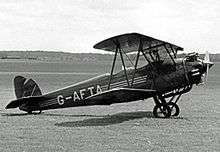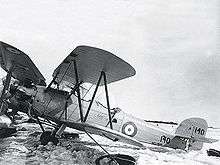Hawker Tomtit
The Hawker Tomtit is a British training biplane from the late 1920s.
| Tomtit | |
|---|---|
_(44441841084).jpg) | |
| Shuttleworth's Tomtit G-AFTA at Old Warden | |
| Role | Trainer |
| Manufacturer | Hawker Aircraft |
| First flight | November 1928 |
| Number built | 35 |
Design and development
The Royal Air Force in 1927 required a replacement for their current elementary trainers, the elderly Avro 504Ns. They specified that the power plant should be an Armstrong Siddeley Mongoose engine, a radial five-cylinder type, and the design should "have regards to the elimination of the Woodworking Fitter trades." In other words: the airframe, though not its covering had to be metal. This led Sydney Camm, then chief designer at Hawker to design the Tomtit, a single bay biplane whose frame was of steel and duralumin tubes. The spars were made of tubular dumbbell sections, the whole aircraft fabric covered. Automatic slats of the Handley Page type were fitted to the leading edges of the upper wing. It had the standard fixed main wheel and tail-skid undercarriage of its day. The engine was uncowled.
Instructor and trainee sat in open tandem cockpits. The latter, at the rear, was provided with the then-new blind flying panel and a cockpit hood was fitted so blind flying instruction was possible. The RAF Tomtits had 150 hp (112 kW) Mongoose IIIC motors. The prototype was first flown by George Bulman in November 1928.
Hawker also produced five civil registered Tomtits.[1] The first two of these started with Mongoose IIIA engine and the third with an upright in-line 115 hp (86 kW) A.D.C. Cirrus Major. It was thought that this latter, lower power engine choice might appeal more to public sporting owners. Three of this group were later owned by Wolseley, who fitted them with their cowled A.R. 7 and A.R.9 radial motors.
Production and service

Between 1928 and 1931, 24 aircraft were delivered to the RAF for evaluation.[2] After the first batch of ten, two more batches of six and eight aircraft respectively were ordered. The competition included the eventual winner, the Avro Tutor. Military Tomtits were sold elsewhere, two to Canada and four to New Zealand.[3][4] Despite its failure to win the RAF contract, it is probable that more Tomtits could have been sold as it was very well received by their pilots but Hawker were very busy producing the Hawker Hart and its many variants and did not have the capacity to manufacture other aircraft. The Cirrus powered machine had turned out to be rather underpowered and lacking the control precision of the standard aircraft.
In 1935 some nine ex-RAF aircraft joined the original five on the civil register.[5][6] They were used by individuals and clubs as sports and training machines. On 04/02/41, three surplus Tomtits were acquired from Leicester Aero Club by Alex Henshaw, the Chief Test Pilot at the Vickers Armstrong Castle Bromwich Aircraft Factory (VACBAF) for use as personal transport until mid-1942. G-AFIB was destroyed in a night take-off accident during the war and Henshaw sold the remaining aircraft in 1946. The third machine, G-AFVV was destroyed at some point soon after the war. survived the war and was acquired and restored by Hawker in 1949. This was donated to the Shuttleworth Collection at Old Warden in 1960. G-AFTA is still operated by the Shuttleworth Collection.
Variants
- Tomtit
- Two-seat training, club, sports and personal aircraft.
- Tomtit Mk I
- Two-seat primary trainer for the RAF.
Military operators

- Royal Canadian Air Force - 2 aircraft.
- No. 7 Squadron RCAF
- No. 12 Squadron RCAF
- Royal New Zealand Air Force - 4 aircraft.
- Pilot Training School
- Royal Air Force - 24 aircraft.
- No. 24 Squadron RAF
- No. 3 Flying Training School
- Central Flying School
Survivors
One Tomtit still flies, the ex-RAF K1786 G-AFTA. This, the last RAF machine, completed in January 1931, initially served No. 3 Flying Training School. It joined the UK civil register in April 1939. During the war, it was flown by Alex Henshaw and gained a Spitfire windscreen and faired headrest. It was acquired and restored by Hawker in 1949 where it became the mount of their test pilot Neville Duke and was painted in the dark blue company colours. In 1960, it was handed over to the Shuttleworth Collection, who returned it to its original RAF colours in 1967.
Specifications (Tomtit)

Data from [7]
General characteristics
- Crew: 2
- Length: 23 ft 8 in (7.21 m)
- Wingspan: 28 ft 6 in (8.69 m)
- Height: 8 ft 8 in (2.64 m)
- Wing area: 238 sq ft (22.1 m2)
- Empty weight: 1,100 lb (499 kg)
- Gross weight: 1,750 lb (794 kg)
- Powerplant: 1 × Armstrong Siddeley Mongoose IIIC 5-cylinder radial engine, 150 hp (110 kW)
Performance
- Maximum speed: 124 mph (200 km/h, 108 kn) at 1,000 ft (300 m)
- Range: 350 mi (560 km, 300 nmi)
- Service ceiling: 19,500 ft (5,900 m)
- Rate of climb: 1,000 ft/min (5.1 m/s)
- Time to altitude: 14.5 min to 10,000 ft (3,000 m)
References
Notes
- Jackson pp. 268–71
- Mason pp. 395–396 (in 1st ed)
- Jackson p. 268
- http://www.adf-serials.com/nz-serials/nz50.shtml
- Jackson pp. 542–543
- British civil reg
- Thetford 1957, pp. 272–273
Bibliography
- Jackson, J.J. British Civil Aircraft 1919–72: Volume II. London: Putnam and Company, 1973. ISBN 0-85177-813-5
- Mason, Francis K. Hawker Aircraft since 1920. London: Putnam & Company, 3rd revised edition 1991. ISBN 0-85177-839-9.
- Thetford, Owen. Aircraft of the Royal Air Force 1919–57 1957. London: Putnam.
- Hannah, Donald. Hawker FlyPast Reference Library. Stamford, Lincolnshire, UK: Key Publishing Ltd., 1982. ISBN 0-946219-01-X.
- James, Derek N. Hawker, an Aircraft Album No. 5. New York: Arco Publishing Company, 1973. ISBN 0-668-02699-5. (First published in the UK by Ian Allan in 1972.)
External links
| Wikimedia Commons has media related to Hawker Tomtit. |
- British civil register http://www.caa.co.uk
- Shuttleworth Collection, Hawker Tomtit